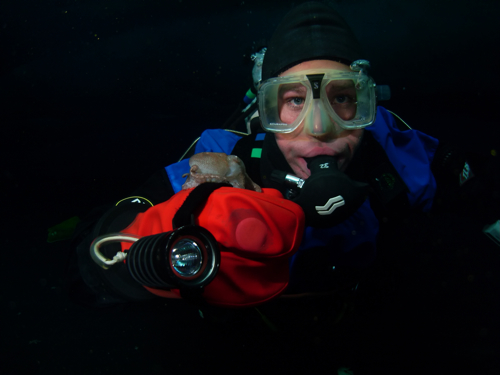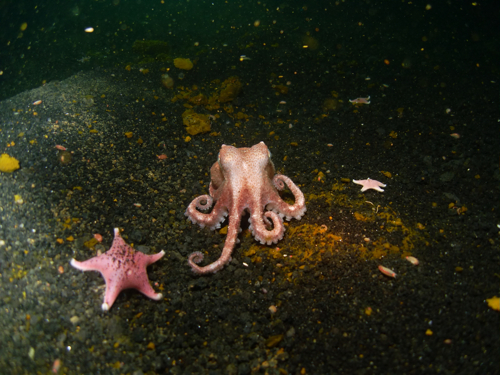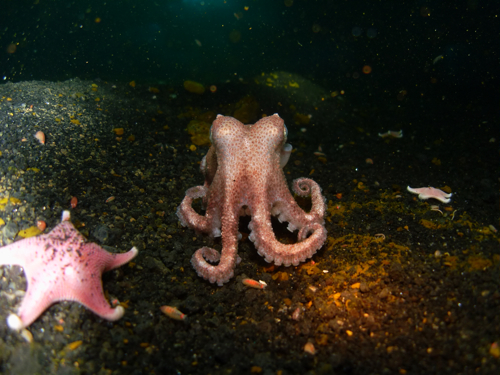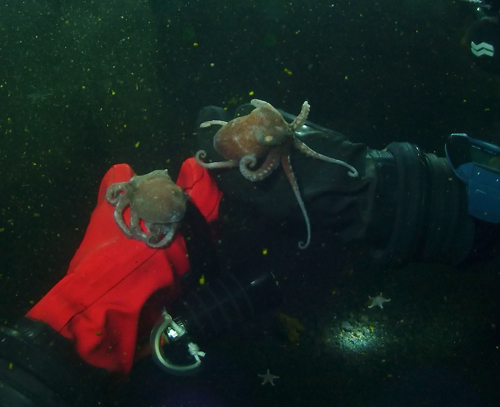Saving the Best for Last
For my last two Antarctic dives, Rob Robbins and Steve Rupp arranged for a new hole to be drilled at a dive site known as Turtle Rock. While I knew it would make for some memorable diving, I didn't know just how memorable!
Meet the Antarctic Octopus
Octopus are classified in the class known as "Cephalopoda", meaning "head-foot". This is a very accurate description for an animal that is basically one large head (mantle) and eight tentacles serving as feet. They are invertebrates, having no backbone and almost entirely soft bodies. In fact, the only hard part on most octopus are their beak-like mouth, located in the center of their underside.

Classification
We organize organisms into different groups based on similarities and differences with other organisms. Here's how we classify (organize) the Antarctic octopus, Pareledone antarctica.

- Kingdom: Animalia
- Phylum: Mollusca
- Class: Cephalopoda
- Order: Octopoda
- Family: Octopodidae
- Genus: Pareledone
- Species: antarctica
Adaptations
Octopus have many unique and interesting adaptations. First, their entirely soft bodies make them excellent at squeezing into narrow places to escape predators. They can fit between narrow gaps in rocks, where few animals can fit.
Second, their eight tentacles or legs are outfitted with suction cups. These are extremely useful for grasping surfaces and prey. The octopus can use these tentacles to open shellfish, grasp fish, or even the giant Antarctic isopod.
Third, octopus show a unique intelligence for invertebrates. In fact, captive octopus seem almost able to solve problems. In fact, given their intelligence and soft bodies, it is often difficult to keep octopus in captivity without their escape.
Finally, octopus have an interesting cardiovascular system. Many species have three hearts: two that pump blood through each of their gills and one that pumps through the rest of their body. Also, their blood uses a copper-rich protein, called hemocyanin, to transport oxygen. Hemocyanin is usually less effective than hemoglobin, but it seems that in colder water conditions hemocyanin is actually more efficient.

Octopus use these physical structures in a variety of ways, but probably the best examples of their behavioral adaptations come in the form of their defensive strategies. Octopus prefer to hide, so as to not be seen. In addition to their soft bodies, they possess the ability to change skin color to try and blend with their surroundings. However, if discovered, octopus may utilize their ability to squirt a black ink in the water. During the confusion, they can then swim away quickly.
Interesting Observations
- In laboratory experiments, octopus can be readily trained to identify colors and shapes.
- Some species of octopus will mimic the shape and movement of other plants or animals.
- Octopus are the only invertebrates shown to use tools.
- Octopus blood is bluish in color.
Summary
Antarctic octopus are a rare site for divers. However, we were so fortunate to see not just one, but two on this dive at Turtle Rock. As my last dives in Antarctica come to a close, I will always remember what a special dive we shared with these amazing animals.



Comments